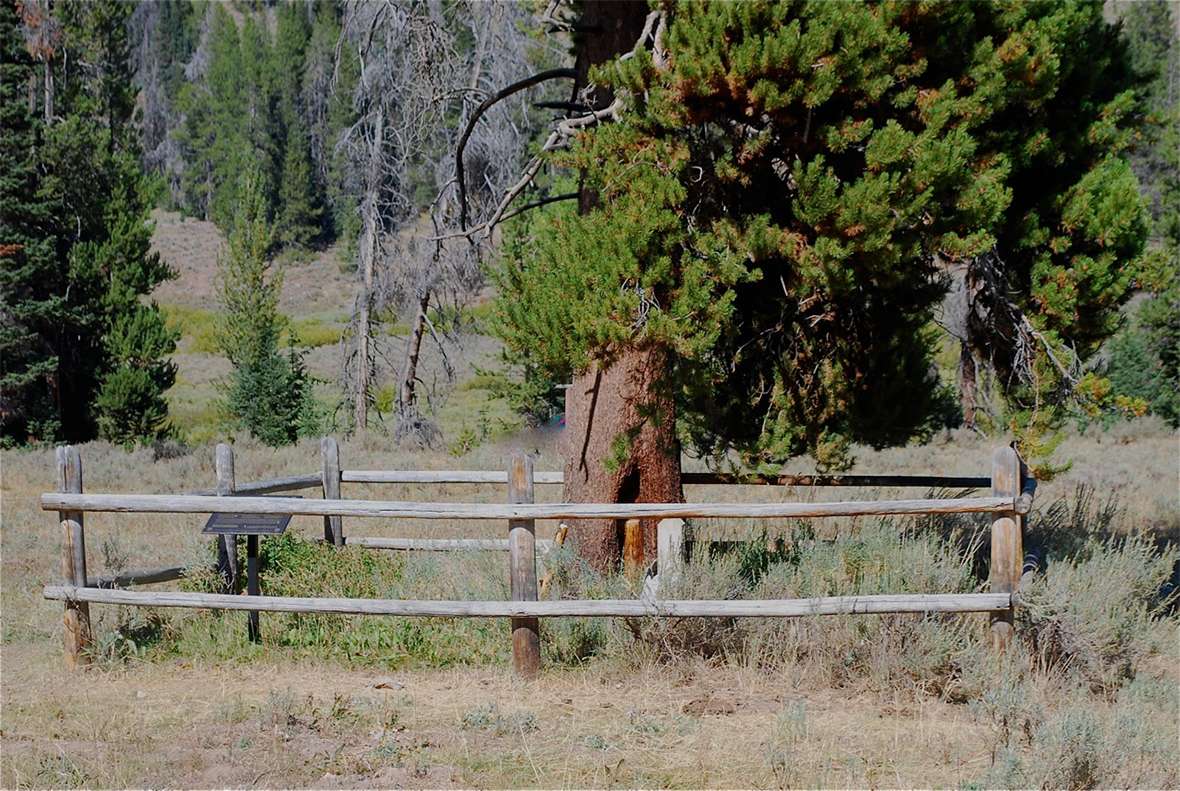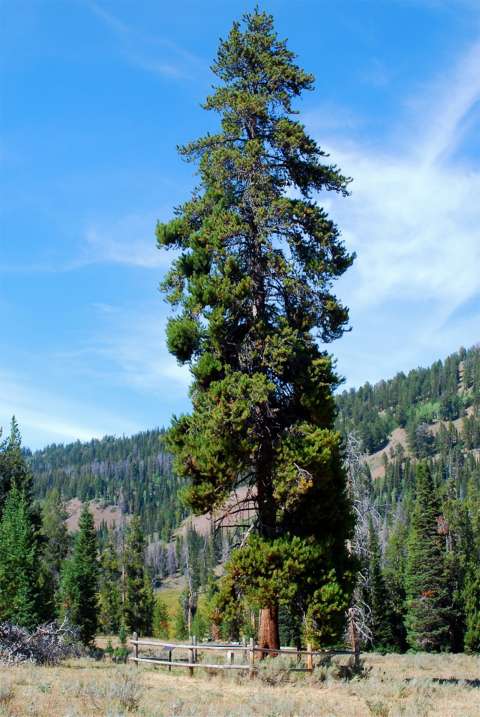- Home
- Encyclopedia
- The Grave of Elizabeth Paul
The Grave of Elizabeth Paul
In the summer of 1862, a large train of 80 wagons was making its way west through mountains in what’s now western Wyoming when serious troubles led to the deaths of two women and their infants within a matter of days.
The grave of one of the mothers, 32-year-old Elizabeth Paul, remains today on the Lander Trail on La Barge Creek in the mountain country of the Salt River Range, Bridger-Teton National Forest.
Elizabeth Mortimore Paul was born in Indiana in 1829, the oldest daughter and second child of Thomas Plymworth Mortimore and Martha (Patsy) Alice Mortimore (née Deshil). Early in the 1830s the Mortimore family moved from Indiana to Wapello County, Iowa, where they eventually became acquainted with the family of Joseph and Mary Paul, Virginians who had moved to Indiana about 1830 and then to Iowa in 1845. Their son Thomas was had been born in Monroe County, Va., now West Virginia, in 1828.

Thomas Paul and Elizabeth Mortimore were married in 1849. Thomas was, like his father Joseph, a farmer and Methodist minister. By 1862, Elizabeth and Thomas were parents of six children: Louisa, age 12; Mary, 10; Isaac, 9; Harriet, 8; Patsy Alice, 5, and Lucinda, age 2. Another son, named Joseph Plymworth Paul for his two grandfathers, was born in 1859 but lived for less than a year.
In 1862, the families of Joseph and Thomas Paul and other relatives joined a company determined to move to the vicinity of Walla Walla in Washington Territory. They left home on April 24. Joseph Paul was selected captain of the outfit, of which a roster survives.
When all the contingents had assembled, the company consisted of 88 men, 69 women, and 86 children under the age of 18. They had 52 ox-drawn wagons, 315 head of cattle, 38 saddle horses, 14 mules, and 38 milk cows, for a total of 404 head of stock. As they headed west, others joined them, and by July 10 it was a train of 80 wagons, 334 people, and 532 head of stock.

There were worries about possible Indian attacks, so companies had come together for mutual protection. By then the overall captain of the wagon train was John K. Kennedy, also from Mahaska County, Iowa. Because of its size or perhaps because of the incompetence and its captain, the company had many problems, especially with stampeding cattle.
When the Pauls left home Elizabeth Paul was pregnant with her eighth child. Apparently, it was a troubled pregnancy. Diarists with the company say they were often delayed because of sickness in the train. There were other pregnant women in the company, but Elizabeth Paul is specifically mentioned on July 5: “We laid in camp until one o’clock on account of Thomas Paul’s wife being sick. She was better at noon so we hitched up.”
On July 16: “The party which was sick is able to travel this morning so we moved on once more.” Again on July 24, “Stayed in camp on account of sickness in the company.” The entries of the last two days may well refer to Elizabeth Paul. By this time many teams in the company, tired of the trouble and delays, had moved on.
Death in childbirth
On the night of July 25, the company’s cattle stampeded twice, and then again on the night of July 26. The next morning, July 27, 1862, Elizabeth Paul died giving birth to her eighth child, a girl.
Diarist Hamilton Scott wrote: “We remained in camp all day. Thomas Paul’s wife died about nine o’clock this morning. She died in childbirth. She has left an infant. She has been very poorly for some time. We buried her this evening under a large pine tree and put a post and railing fence around her grave.” Thomas Paul named the baby Elizabeth.
The Pauls’ oldest child, Louisa, believed six decades later that the last of these stampedes had something to do with her mother’s death: “Father being on guard at the time caused Mother a great deal of worry, and the excitement causing premature confinement she died the next day. … The baby lived but a week, and was buried a week later after Mother’s death. The ladies made up some verses and put them on a board which they placed at the head of Mother’s grave. The men made paling and put it all around her grave.”
Diarist Jane Gould’s company caught up to the Kennedy train on July 28, when she wrote: “Came past a camp of thirty-six wagons who have been camped for some time here in the mountains, they have had their cattle stampeded four or five times, there was a woman died in their train yesterday, she left six children and one of them only two days old, poor little thing it had better died with its mother, they made a good picket fence around the grave.”
Henry Judson, another emigrant from Iowa, came by on July 29: “We pass this afternoon a beautiful grave made in an opening in the forest & directly beneath a fine fir tree—Twas made on the 27th inst (only 2 days ago) & was enclosed in a picket yard of hewn timber—a board set into a notch sawed into the tree informed us that the grave contained the remains of Mrs. Elizabeth Paul—aged 32 years—beneath some kind friend had pinned a paper on which were written 3 beautiful & appropriate verses & which I regret very much I had not time to copy.”
James McClung was a member of the Paul company and in his diary entry of July 27, he included the three stanzas of the verse left at the grave: “Elizabeth Wife of Thomas Paul died and was buried this afternoon near the foot of the mountain aged 32 years 7 months and 27 days this is a day of sorrow indeed.”
The first stanza was a well-known early 19th century epitaph:
Friends and physytions could not save
This mortal lovely body from the grave
Nor can the grave confine it here
When God commands it to appear
For tho it was her lot to die
Hear among the mountains high
Yet when gabriels trump shall sound
Among the blessed she will be found
And while she rests beneath this tree
May holy angels watch and see
That naught disturbs her peaceful day
Until the dawning of the day
On July 29, after gathering up all but four of their lost cattle, the company moved on. In the next few days they traveled through Star Valley, entered the mountains again after crossing what’s now the Wyoming-Idaho state line and camped the evening of Aug. 1 near Lane’s Creek.
“[G]ot through the mountains today,” a diarist wrote that evening. Their troubles were far from over, however.
A stampede and more deaths
The next day, Aug. 2, they experienced another devastating stampede. Twenty-five teams ran away, and several people were badly injured. Mrs. Nancy Townsend attempted to jump from her run-away wagon, but hampered by her advanced pregnancy, she wasn’t able to clear the wagon. She was run over by its heavy wheels and badly crushed. The next day she suffered a miscarriage, and she and the baby died soon after. Nancy Townsend, wife of Samuel Townsend, was 21.
On the night of Aug. 2, the week-old infant, Elizabeth Paul, died. She was buried at noon the next day, about the time Nancy Townsend passed away. Jane Gould wrote: “We passed by the train I have just spoken of, they had just buried the babe of the woman who died a few days ago, and were just digging grave for another woman that was run over by the cattle and wagons when they stampeded yesterday. She lived twenty-four hours. She gave birth to a child a short time before she died; the child was buried with her. She leaves a little two-year old girl and a husband, they say he is nearly crazy with sorrow."
The graves of Nancy Townsend and child, and that of Elizabeth Paul’s infant, are a mile or two east of Gray’s Lake on the Lander Trail, but the exact sites are now lost. The grave of mother Elizabeth Paul, however, still survives.
Julius Merrill was there on Aug. 15, 1864, and wrote: “Passed a grave enclosed by a picket fence, painted white. A lovelier spot I never saw. There was an opening of perhaps, half an acre, with one large shady pine near the center. Under this lone tree was the grave. The beauty of the place and the care bestowed upon the remains of the woman cause us all to look at it.” The gravesite has much the same appearance today. The original pine tree still stands over the grave.
Thomas Paul went on to Washington Territory and settled on Dry Creek, six miles north of Walla Walla, and married again to Susan Zaring (née Ellis) in 1863. They had four more children. Thomas Paul died in 1904 and is buried in Mountain View Cemetery in Walla Walla.
Resources
Sources
- “Another Pioneer Dead.” The Evening Statesman, Walla Walla, WA. vol. XXXI, no. 168. September 29, 1904, p. 1, col. 3.
- Estes, Louisa J. “Reminiscences Of Mrs. Louisa J. Estes At Age 75 Of Her Trip Across The Plains Over The Old Oregon Trail By Ox Team In 1862.” typescript by Pauline E. Thompson. Cage 676, Box 3. Pauline E. Thompson Collection. Chapter 5, “My Genealogy.” Six pages. 1994. Washington State University Library, Pullman, WA.
- Find a Grave. “Nancy J. Townsend.” findagrave.com, accessed April 25, 2017 at https://findagrave.com/cgi-bin/fg.cgi?page=gr&GSln=Townsend&GSiman=1&GScnty=210&GRid=133924027&
- Find a Grave. “Thomas Plemworth Mortimore.” Findagrave.com, accessed April 25, 2017 at https://www.findagrave.com/cgi-bin/fg.cgi?page=gr&GRid=42554781
- Gould, Jane Augusta Holbrook. The Oregon & California Trail Diary of Jane Gould in 1862. Ed. by Bert Webber. Medford, OR: Webb Research Group, 1997.
- Iowa, Mahaska County. Cedar Township. 1860. U. S. Census.
- Judson, Henry M. Diary, 1862. MS 953, Nebraska State Historical Society. Typescript, 137 pages.
- McCarley, Jayne. Roots Web. “Reconstruction of Roster of 1862 Kennedy Company, John Knox Kennedy, Capt.” Pat Packard and Marjorie Ellis Miles. Additions and corrections by Ella Jane Allison McCarley. Originally published April 1993. vol. 36, no. 2. Yakima Valley Genealogical Society. Accessed April 25, 2017 via www.rootsweb.ancestry.com/~orgenweb/ReconstructionofRosterof1862-2.doc.
- McClung, James Scott. Diary and Letters, 1862. Mss 1508, Oregon Historical Society. Transcribed by Richard L. Rieck.
- Merrill, Julius. Bound for Idaho: The 1864 Trail Journal of Julius Merrill. Edited by Irving R. Merrill. Moscow, Idaho, University of Idaho Press, 1988.
- Scott, Hamilton. A Trip across the Plains in 1862. Mss 596, Oregon Historical Society. Typescript, 10 pages.
- Wyoming State Historic Preservation Office. “Elizabeth Paul Grave.” Emigrant Trails Across Wyoming. Accessed April 25, 2017 at http://wyoshpo.state.wy.us/trailsdemo/elizabethpaul.htm.
Illustrations
- Both photos are by the author. Used with permission and thanks.
